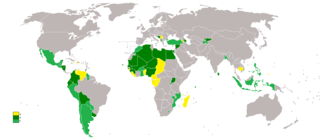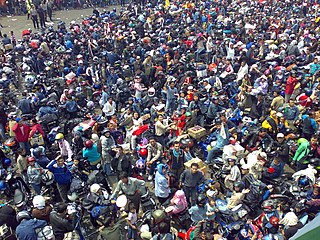 W
WA migrant worker is a person who either migrates within their home country or outside it to pursue work. Migrant workers usually do not have the intention to stay permanently in the country or region in which they work.
 W
WThe Ayahs' Home, London, provided accommodation for Indian ayahs and Chinese amahs (nannies) at the turn of the 20th century who were "ill-treated, dismissed from service or simply abandoned" with no return passage to their home country. The Home also operated like an employment exchange to help ayahs find placements with families returning to India. It was the only institution of its type in Britain with a named building.
 W
WDigital nomads are people who use telecommunications technologies to earn a living and, more generally, conduct their life in a nomadic manner. Such workers often work remotely from foreign countries, coffee shops, public libraries, co-working spaces, or recreational vehicles. This is often accomplished through the use of devices that have wireless Internet capabilities such as smartphones or mobile hotspots. Successful digital nomads typically have a financial cushion or need to develop high levels of self-reliance and self-discipline. The digital nomad community has had various events established to host members of it. Common types of digital nomads include retired or semi-retired persons, independently wealthy or entrepreneurs, and remote workers. People typically become digital nomads for positive reasons, such as financial independence and a career that allows for location independence. Although digital nomads enjoy advantages in freedom and flexibility, they report loneliness as their biggest struggle, followed by burnout. This lifestyle may present other challenges as well such as maintaining international health insurance with coverage globally, abiding by different local laws, and sometimes obtaining work visas.
 W
WThe Harvest Gypsies is a series of articles by John Steinbeck written on commission for The San Francisco News focusing on the lives and times of migrant workers in California's Central Valley. Published daily from October 5–12, 1936, Steinbeck delves into the hardships and triumphs of American migrant workers during the Great Depression, tracing their paths and stories from crop to crop as they eked out a stark existence.
 W
WHarvest of Shame was a 1960 television documentary presented by broadcast journalist Edward R. Murrow on CBS that showed the plight of American migrant agricultural workers. It was Murrow's final documentary for the network; he left CBS at the end of January 1961, at John F. Kennedy's request, to become head of the United States Information Agency. An investigative report intended "to shock Americans into action," it was "the first time millions of Americans were given a close look at what it means to live in poverty" by their televisions.
 W
WIndian migrant workers during the COVID-19 pandemic have faced multiple hardships. With factories and workplaces shut down due to the lockdown imposed in the country, millions of migrant workers had to deal with the loss of income, food shortages and uncertainty about their future. Following this, many of them and their families went hungry. Thousands of them then began walking back home, with no means of transport due to the lockdown. In response, the Central and State Governments took various measures to help them, and later arranged transport for them. 198 migrant workers died due to the lockdown, with reasons road accidents.
 W
WThe International Convention on the Protection of the Rights of All Migrant Workers and Members of Their Families is a United Nations multilateral treaty governing the protection of migrant workers and families. Signed on 18 December 1990, it entered into force on 1 July 2003 after the threshold of 20 ratifying States was reached in March 2003. The Committee on Migrant Workers (CMW) monitors implementation of the convention, and is one of the seven UN-linked human rights treaty bodies.
 W
WChildren of migrant workers struggle to achieve the same level of educational success as their peers. Relocation causes discontinuity in education, which causes migrant students to progress slowly through school and drop out at high rates. Additionally, relocation has negative social consequences on students: isolation from peers due to cultural differences and language barriers. Migrant children, defined as those who relocate because of involvement with agriculture-related industries or other seasonal work, are also at a disadvantage because the majority live in extreme poverty and must work with their parents to support their families. These barriers to equal educational attainment for children of migrant workers are present in countries all over the world. Although the inequality in education remains pronounced, government policies, non-governmental organizations, non-profits, and social movements are working to reverse its effects.
 W
WMigrant Schools are a type of schools for migrant students in China. The teachers and managers of these schools usually come from countryside, just as the migrant students in these schools. In China, if a student want to be accepted by a primary school or secondary school, he/she must have a local household registration record ("Hukou"). However, for those migrant workers (Mingong), they and their children usually don't have local household registration record. That means their children will not be accepted by schools in the city they work in. Thus they have to send their children to "Migrant Schools" run privately.
 W
WThe Migrants is a CBS television movie that was broadcast on February 3, 1974.
 W
WMingong are migrant workers in the People's Republic of China, who, starting in the last decades of the 20th century, have been travelling from the countryside to the cities to work. It is a recent phase of migration in China.
 W
WMudik is an Indonesian term for the activity where migrants or migrant workers return to their hometown or village during or before major holidays, especially Lebaran. Although the mudik homecoming travel before Lebaran takes place in most Indonesian urban centers, the highlight is on the nation's largest urban agglomeration; Greater Jakarta, as millions of Jakartans exit the city by various means of transportation, overwhelming train stations and airports and also clogging highways, especially the Trans-Java toll road and Java's Northern Coast Road.
 W
WThe term "perpetual traveler" refers to the idea that by basing different aspects of one's life in different countries and not spending too long in any one place, a person can reduce taxes, avoid civic duties, and increase personal freedom. Books and services relating to the PT idea have been a staple of companies that specialise in marketing offshore financial services, tax avoidance schemes, and personal privacy services.
 W
WThe Swabian children were peasant children from poor families in the Alps of Austria and Switzerland who went to find work on farms in Upper Swabia and the Swabian Jura. Usually they were sent by their parents to become seasonal workers. They were taken in spring and brought to the child markets in Germany, mainly in Upper Swabia, where they would be purchased or "rented" by farmers for the season. This use of children as workers was most widespread in the 19th century.
 W
WUnited Voices of the World (UVW) is an independent grassroots trade union, established in 2014, with a reported membership of over 3,000.